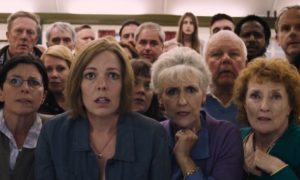 Review: One Night Only
Review: One Night Only
London Road | Rufus Norris | UK | 2015 | 93 minutes
Spotlight Cinema, Madison Museum of Contemporary Art, Wednesday, November 2, 7:00pm.»
James Kreul argues that London Road evokes a surprising range of emotions in what could have been a conceptual exercise: singing words taken from interviews about an infamous series of prostitute murders.
Between 2006 and 2008 five prostitutes were murdered in Ipswich, England, and the man eventually arrested in the case, Steve Wright, lived on London Road. Extensive media coverage of the case transformed the community, and how it saw itself.
London Road adapts a National Theater production written by Adam Cork and Alecky Blythe, which utilized transcripts of interviews with Wright’s neighbors and others in the London Road neighborhood. The cast, led by the great Olivia Coleman (Broadchurch) not only replicates the interviews verbatim, they also sing the words, often repeating them to create a rhythmic chorus.
My emotional response to what could have been a conceptual exercise often surprised me. London Road delivers a compelling examination of the hopes and aspirations of those who remained in the community after the tragedy.
The singing works best when the actors toggle between speech and song, which allows them to stay “small” instead of going “big” like an all-out musical sequence. The weakest moments in the film are the biggest ones, which come close to traditional musical numbers, and will unfortunately remind some viewers of the “Everyone Has Aids” number from the Rent parody in Team America.
Two of the strongest moments are small and intimate. Tom Hardy (Mad Max: Fury Road) provides some surprise star power as Mark the cab driver. His rhythmic, repetitive analysis conveys not only the anxiety in Ipswich when the murderer is still on the loose but also the obsessive levels with which residents follow the case in a town where otherwise not much happens. Late in the film, we finally hear from prostitutes struggling to leave the profession, and addictions that accompany it, who are frustrated that it took the lives of five women to finally persuade people that they needed help.
The structure of the film, more than the singing, could present a challenge to general viewers. While the central news story is obviously dramatic, the film itself lacks dramatic conflict. The neighbors follow the case after Wright’s arrest, but they’re not directly engaged with the legal drama. Rather than focusing on a single protagonist trying to achieve a goal, we follow a group of neighbors who have a broad goal of improving their neighborhood, but who don’t pursue specific tactics to do so until the third act.
Without such a goal driven narrative, in theory we could just hop from character to character forever without a clear end in sight. This structure led Leah Greenblatt at Entertainment Weekly to conclude, “it all feels about as cohesive and compelling as having a bunch of strangers who sound like Dick Van Dyke in Mary Poppins loudly hum the headlines from their local police blotter in your ear.” She has a point, but only because she’s expecting what the film does not attempt to deliver. Others have dismissed the film as “canned theater,” too closely tied to the stage production and not “cinematic.”
Without a strong central dramatic conflict, responses to the film depend on tolerance to repetition and variation, which provides the structuring principle within individual scenes more often than dramatic conflict. Greenblatt obviously had a low tolerance for this. While not “cinematic” in the sense of dynamic visual action, this technique does provide a complex sensory experience that surprisingly produces a range of emotional responses.
A news report discussing DNA evidence presented on a single stage in the original production is presented in the film as a series of cross cuts between the reporter struggling with his script outside of Wright’s house, and neighbors speculating about Wright’s guilt during a community gathering. The singing unifies the two spaces, and again because the performances are allowed to remain relatively small, the sequence quite effectively conveys the anxiety felt among the community members. In both spaces, the reporter and the community members repeatedly sing the key passage of the report, transforming a mundane scientific detail into a rousing anthem that unifies and comforts the community.
Olivia Coleman consistently cuts through the conceptual aspects of the production and delivers an intriguing characterization in her portrayal of Julie, a mother who wants to raise her teenage daughter in a safe neighborhood. Julie does not hide her contempt for the prostitutes whom she blames for the tragedy. In an emotionally provocative scene, with her daughter sitting next to her, Julie goes so far as to say she would shake Wright’s hand, if she had the courage to do so. In this and several other scenes, Coleman conveys the complex class issues at play in London Road in concise, compelling moments.
When director Rufus Norris goes big, like the elaborate “London Road in Bloom” sequence at the end, the film is far less compelling, and a bit heavy handed. But in general the singing and the rhythmic repetition of lyrics provides enough of a defamiliarization effect to provide a fresh perspective on community and class dynamics in England.